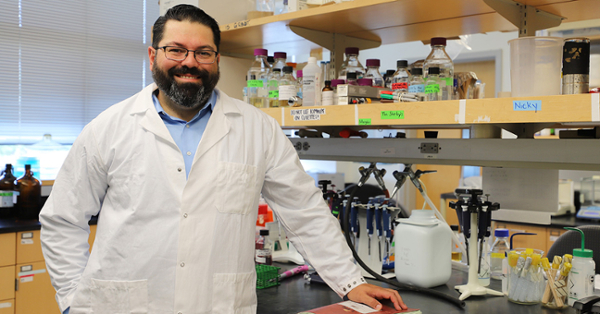Research team finds potential method for earlier ovarian cancer detection
Research team finds potential method for earlier ovarian cancer detection

Ovarian cancer ranks among the deadliest forms of cancer, impacting nearly 20,000 newly diagnosed women each year. The earlier ovarian cancer is diagnosed, the better chance a person has of surviving five years after diagnosis. Yet, only a quarter of ovarian cancers are detected in the first stage, due in part to the lack of reliable, noninvasive screening methods.
Gregory Caputo, Ph.D., a professor of chemistry and biochemistry in the College of Science & Mathematics, is part of a research team led by Virginia Commonwealth University (VCU) that identified a potential method for detecting ovarian cancer that requires only a urine sample, instead of a tissue biopsy.
In a recent study published in the American Chemical Society’s journal, ACS Sensors, the team highlighted the effectiveness of nanopore-sensing technology in detecting and discriminating select peptides associated with ovarian cancer.
“Ovarian cancer has a pretty poor set of outcomes, partly because it's very difficult to diagnose,” Caputo said. “We were definitely motivated by the urgent need for improved ovarian cancer diagnostics."
Peptides, small pieces of proteins, play a crucial role in various biological processes and serve as important biomarkers for diseases, including cancer. However, biomarkers are not currently being used in ovarian cancer diagnostics. Instead, ovarian cancer is typically diagnosed following general surgery and a tissue biopsy, which can be invasive and painful for patients.
The research team developed a new method that uses nanopore-sensing technology to overcome the challenges of detecting biologically relevant peptides. Nanopore sensing is a highly efficient and low-cost method that has been successful in selectively detecting cysteine-containing peptides, which play various roles in ovarian cancer biology, contributing to drug response, therapeutic targeting and, critically, biomarker identification. However, the technique had never been applied to detect biologically relevant peptides to ovarian cancer.
The research team used gold cluster-enhanced nanopores combined with nanopore-sensing technology to selectively detect cysteine-containing peptides found only in the urine of ovarian cancer patients. The method has the potential to significantly improve early detection and treatment of ovarian cancer while reducing the need for invasive biopsies.
Aashna Jonnalagadda, a molecular and cellular biology major at Rowan University, who also contributed to this research, emphasized the transformative potential of this peptide-sensing technique.
"Replacing the tissue biopsy needed to detect this type of cancer with the nanopore-based, peptide-sensing technique could be a pioneering project that could influence the detection method for several other diseases,” Jonnalagadda said.
The study was funded by the National Science Foundation (CBET – 2011173). Caputo envisions a future where the technology is more broadly accessible for use in clinical settings. The team is seeking additional funding to improve the technique by enhancing its sensitivity and standardizing protocols to simplify the detection process.
With further advancements and refinement, Caputo is optimistic that this groundbreaking technology can one day revolutionize disease detection protocols, offering faster, noninvasive, and more accurate methods for diagnosing various medical conditions.
"We believe that, with sufficient resources and support, we can accelerate the development and deployment of this technology," Caputo said. "Our ultimate goal is to make a tangible difference in patients' lives by enabling earlier detection and intervention."
The research team was led by Joseph E. Reiner, a VCU physics professor. In addition to Rowan University alumna Victoria Tagliaferro, the VCU authors included: Thomas W. Rockett, Mohammed Almahyawi, Madhav L. Ghimire, Sarah J. Seashols-Williams and Massimo F. Bertino.